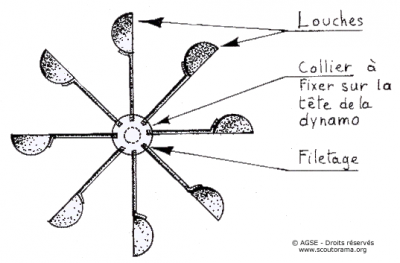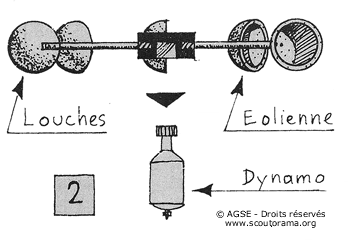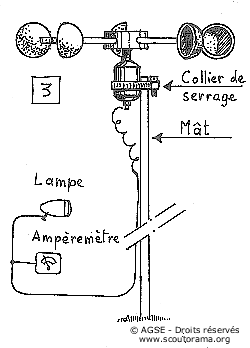
For the record
It is good to have plenty of ideas, it is even better to know how these ideas can bring you some energy. Sustainable energy is everywhere, all you need to know is how to use it.
We will here talk about wind. Thank’s to God wind can be found almost everywhere especially on the coast. That’s for sure, you can trust me !
Of course, you will always be dependant, you never know, there could be some times without any wind at all. Let it be said, we are always in the hands of God, and that’s a good way to keep it in mind.
Nowadays it’s very easy to put electric lighting inside a tent. You can even think about having electric lighting in your whole camp. It’s often very useful, especially in winter, when the sunset is early. No need to have a torch with you at all times. And to hell with individualism !
A few ladles, a bike’s dynamo,some electric wire, tubes, guy ropes and a lamp will do the trick to have decent electric lighting in your tent if the winds are strong enough (8 - 11 kt)
This device is light and can be dismantled. You will carry it easily in a backpack.
It’s the ladle anemometer.
The first use of this device is for meteorological records. It can be used for that purpose by the patrol’s "Mr. weather forecast". In that case you will need to replace the lamp by an ammeter that you will have previously calibrated to measure the wind speed in knots, or even better with the Beaufort scale.
I think that there’s nothing such as a good picture to show you how to build the device.
The material you will need
- 8 ladles
- 1 bike dynamo
- 1 ring, that fits the head of the dynamo.
- Electric wire
- 1 bike lamp or 1 ammeter
- 4 guy ropes
- 4 tubes such as those used for tent poles
The device

1° Mount the 8 ladles on the ring, try to screw them in, that way you will dismantle the device more easily.
2° Fit the ring with the ladles on the head of the dynamo

3° Put the dynamo at the top of the tube pole (a clamp should do the trick)
4° Use shrouds to set the pole in a windy area .

5° Plug the bike lamp on the electric wire linked to the dynamo (That’s how you get free electricity !)


